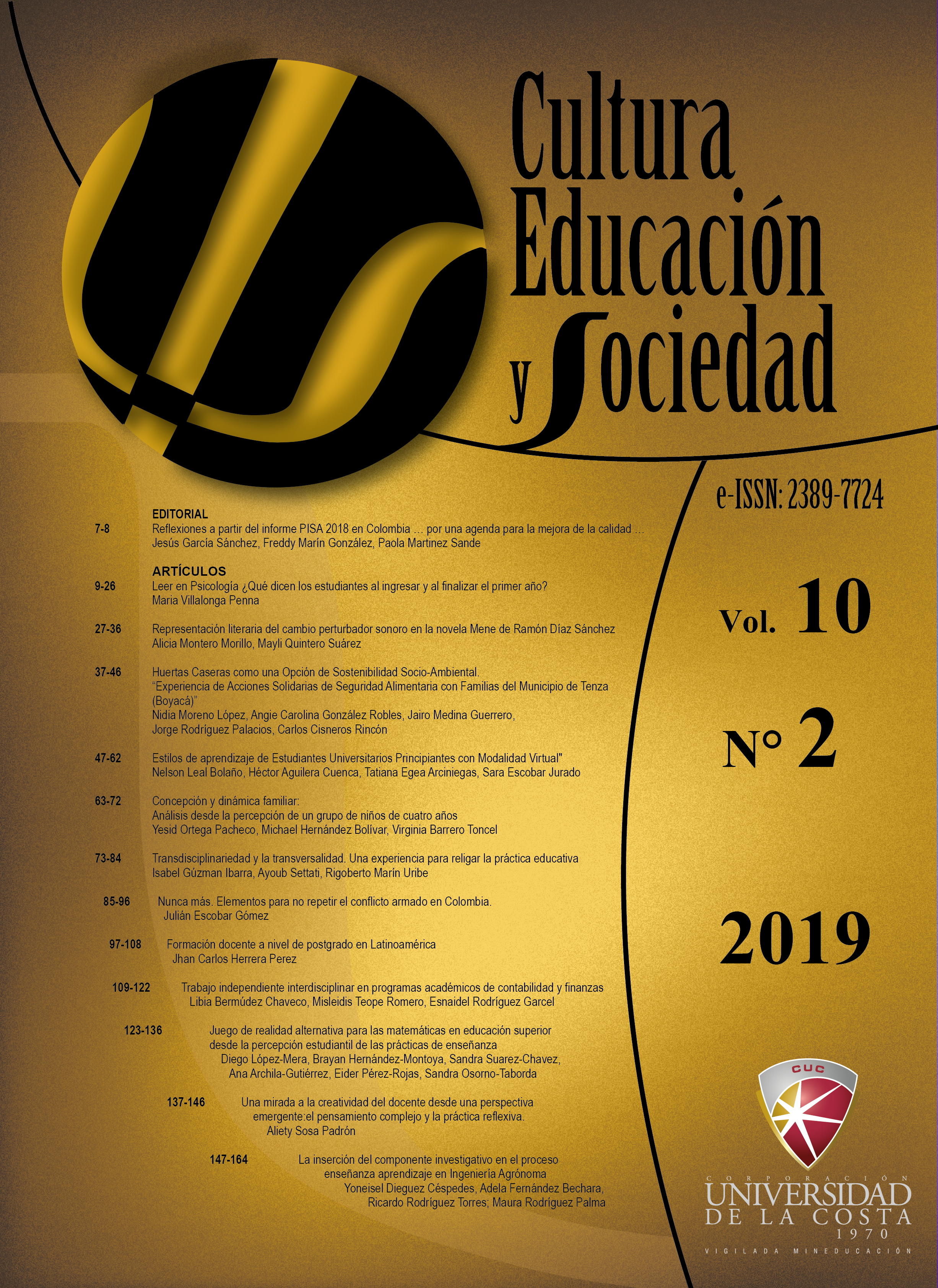Learning styles of beginning university with virtual modalit
DOI:
https://doi.org/10.17981/cultedusoc.10.2.2019.04Keywords:
Learning styles, University students, Beginners, Virtual modalityAbstract
The research aims to characterize the learning styles of beginning university students with virtual modality. The preponderance of each of the styles proposed by Felder and Silverman (1988) is described. In the methodological it is a mixed study of an exploratory - descriptive nature where 5951 students assigned to academic programs oriented from virtuality participated. The main results highlight that students have a predominance of learning styles oriented to the active, reflexive and visual. It is concluded in the relevance of identifying actions that meet the needs of the students in such a way that they feel motivated and strengthen their sense of institutional belonging, so that they appropriate the virtual mediation didactics and improve their academic performance.
Downloads
References
Aguirre, M., Cancino M. O. y Loaiza N. (2009). Estilos de aprendizaje: una propuesta didáctica para la enseñanza de lenguas extranjeras. Cali: Universidad del Valle,
Alonso, C. M., Gallego, D. J. y Honey, P. (1994). Los estilos de aprendizaje. Procedimientos de diagnóstico y mejora. Bilbao: Mensajero.
Aragón, M. y Jiménez, Y. (2009). Diagnóstico de los estilos de aprendizaje en los estudiantes: Estrategia docente para elevar la calidad educativa. CPU-ea, (9), 1–21.
Camarero, F., del Buey, F. M., & Herrero, J. (2000). Estilos y estrategias de aprendizaje en estudiantes universitarios. Psicothema, 12(4), 615–622.
Cazau, P. (2001). Estilos de aprendizaje. [Online]. Recuperado de https://vdocuments.mx/estilos-de-aprendizaje-pablo-cazau-bueno.html
Chavero, B. (1999). Hipermedia en Educación. El modo escritor como catalizador del proceso enseñanza-aprendizaje en la enseñanza secundaria obligatoria. [Tesis Doctoral]. Universidad de Extremadura, Instituto de Ciencias de la Educación, Badajoz, España.
Chevrier, J., Fortin, G., Théberge, M. & Le Blanc, R. (2000). Le LSQ-Fa: une version française abrégée de l'instrument de mesure des styles d'apprentissage de Honey et Mumford. Le style d’apprentissage, 28(1), 1–137. Recuperado de https://www.acelf.ca/c/revue/revuehtml/28-1/07-chevrier.html
Curry, L. (1987). Integrating concepts of cognitive or learning style: A review with attention to psychometric standards. Otawwa: Canadian College of Health Service Executives.
Díaz-Barriga, F. y Hernández G. (2003). Estrategias docentes para un aprendizaje significativo: una interpretación constructivista, 2 ed. México, D.F.: McGraw Hill.
Dunn, R., Dunn, K. & Price, G. (1985). Manual: Learning Style Inventory. Lawrence: Price Systems.
Durán, E. y Costaguta, R. (2007). Minería de datos para descubrir estilos de aprendizaje. Revista Iberoamericana de Educación, 42(2), 1–10.
Felder, R. y Brent, (1996). Matters of Style. ASEE Prism, 6(4), 18–23.
Felder, R. M. & Silverman, L. K. (1988). Learning and Teaching Styles in Engineering Education Application. Journal of Engineering Education, 78(7), 674-681.
Felder, R. y Spurlin, J. (2005). Applications, Reliability, and Validity of the Index of Learning Styles. International Journal of Engineering Education, 21(1), 103–112.
Ferrel, F., Thomas, J., Solano, A., Redondo, E. y Ferrel, L. (2014). Bienestar psicológico en profesores de una Universidad privada del distrito de Santa Marta. Cultura Educación y Sociedad, 5(2), 61–76. Recuperado de https://revistascientificas.cuc.edu.co/culturaeducacionysociedad/article/view/885
García, J. Santizo, J. y Alonso, C. (2009). Uso de las TIC de acuerdo a los estilos de aprendizaje de docentes y discentes. Revista Iberoamericana de Educación, 48(2), 1–14.
Garza, R. y Leventhal, S. (2000). Aprender cómo Aprender. México, D.F.: Trillas.
Grasha, A. F. & Riechmann, S. W. (1975). Student learning styles questionnaire. Cincinatti: University of Cincinatti.
Hernández, R. Fernández, C. y Baptista, M. (2010). Metodología de la Investigación. México, D.F.: Mc Graw Hill.
Jensen, E. (1994). Unlocking The Code: Learning Styles. Brain Based Learning and teaching. Beirut: Turning Point Publisher.
Johnson, R. & Onwuegbuzie, A. (2004). Mixed method research: A research paradigm whose time hascome. Educational Researcher, 33(7), 14–26. https://doi.org/10.3102/0013189X033007014
Keefe, J. (1988). Aprendiendo Perfiles de Aprendizaje: manual de examinador. Reston: Asociacion Nacional de Principal de Escuela de Secundaria.
Kolb, D. A. (1984). Experiential learning: experience as the source of learning and development. New York: Prentice hall.
Litwin, E. (1997). Las configuraciones didácticas. Buenos Aires: Paidos.
Mc Carthy, B. (1987). El Sistema MATE: enseñando a aprender tren con métodos de izquierda derecha técnica. 2 ed. Barrington: Superar.
Pearson, R. (2007). Estilos de aprendizaje. [Online]. Recuperado de https://www.jelaprendizaje.org/
Pérez, J. (2001). Programación Neurolingüística y sus estilos de aprendizaje. [Online]. Recuperado de http://www.aldeaeducativa.com
Revilla, D. (1998). Estilos de aprendizaje. Temas de Educación. [Segundo Seminario Virtual]. Lima: Pontificia Universidad Católica del Perú.
Rodríguez, J., G. Fajado, F. Higuera y González, J. (2006). Estilos de aprendizaje en internos de pregrado. Revista Hospital General Dr. M. Gea González, 7(3), 102–107.
Roset, T. B. (2003). Los estilos de aprendizaje. [Online]. Recuperado de http://www.monografias.com/trabajos12/losestils/losestils
Senior, A., Colina, J., Marín, F., Perozo, B. (2012). Visión complementaria entre los métodos cualitativos y cuantitativos en la investigación social. Una aproximación teórica. Muticiencias, 12(Extraordinario), 106–114.
Troyano, H., Breitman, M. y Gete-Alonso, C. (2004). Estilos de aprendizaje que predominan entre los estudiantes universitarios. Revista de enseñanza universitaria, (23), 63–82.
Valadez, M. (2009). Estilos de aprendizaje y estilos de pensamiento: precisiones conceptuales. Revista de Educación y Desarrollo, (11), 19–30.
Wenden, A. L. (1991). Learner strategies for learner autonomy: Planning and implementing learner training for language learners. Hertfordshire: Prentice-Hall International.
Willing, K. (1988). Learning Strategies as information management: some definitions for theory of learning strategies. Prospect, 2(3), 139–155.
Witkin, H. (1985). Estilos Cognoscitivos naturaleza y orígenes. Madrid: Pirámide.
Woolfolk, A. (1996). Psicología Educativa. México, D.F.: Pearson.
Published
How to Cite
Issue
Section
License
Copyright (c) 2019 CULTURA EDUCACIÓN Y SOCIEDAD

This work is licensed under a Creative Commons Attribution-NonCommercial-NoDerivatives 4.0 International License.
![]()
Creative Commons 2020 CULTURA EDUCACIÓN Y SOCIEDAD
This article is under international license Creative Commons Reconocimiento-NoComercial-SinObrasDerivadas 4.0.
The published articles are the sole responsibility of their authors and do not necessarily reflect the opinions of the editorial committee.
CULTURA EDUCACIÓN Y SOCIEDAD respects the moral rights of its authors, who assign to the editorial committee the patrimonial rights of the published material. In turn, the authors inform that this work is unpublished and has not been previously published.
All articles are under a:
Licencia Creative Commons Atribución-NoComercial-SinDerivadas 4.0 Internacional.
![]()


 English
English
 Español (España)
Español (España)




_12.53_.27_p_. m_._3.png)





_12.57_.35_p_. m_._3.png)
_12.50_.37_p_. m_._3.png)



